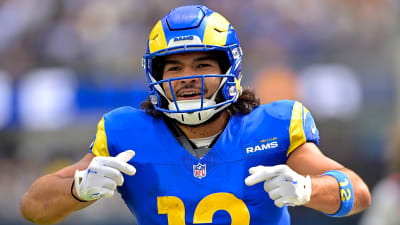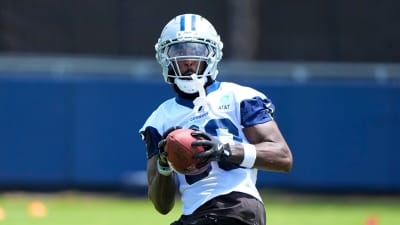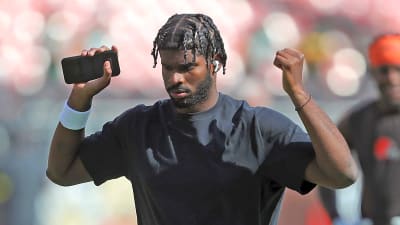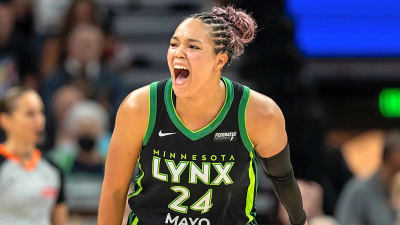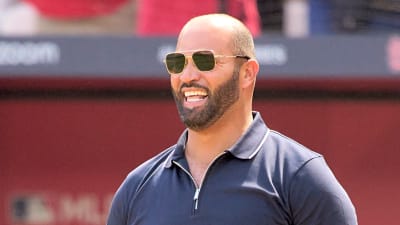The Edmonton Oilers made a trade on October 1, acquiring goaltender Connor Ingram from the Utah Mammoth. Trading at this time of year is a fairly rare event, as most teams have their rosters set and usually will try to sneak players through waivers since, well, everyone is doing it.
But despite their rarity, the Oilers have in fact made some late training camp trades in the past. Were any noteworthy that should give the Oilers some hope that this Ingram one will pan out? While we could look at the trades over a long period of time to judge them (such as the Nail Yakupov trade resulting in the Oilers ending up with the draft pick to pick Stuart Skinner), we will limit this to looking at trades that actually had an effect for the Oilers the season they were made.
October 9, 2022: Klim Kostin for Dmitri Samorukov
This was the most recent training camp trade, with the Oilers and St. Louis Blues swapping young players who hadn’t quite panned out. The Oilers acquire Klim Kostin from the Blues in exchange for Dmitri Samorukov. Apparently the Oilers and Blues really liked making training camp trades, as this was the third training camp trade the teams made in the past seven years (although those days are likely out the window following last year’s offersheets).
Like Ingram, both players were waived prior to the trade, and upon the swap being made still went to their new franchise’s AHL team.
Kostin wasn’t in the AHL long though, earning a call up after nine games. He went on to play 57 games for the Oilers, scoring 11 goals and 21 points, becoming a fan favourite along the way. He also posted five points in 12 playoff games as well. His performance unfortunately priced him out of Edmonton, and so the team traded him to the Detroit Red Wings who signed him to a two-year, $2M AAV contract.
Samorukov meanwhile would play just two games in the NHL with the Blues before heading back to Russia. So even though Kostin didn’t end up staying, the Oilers still came out ahead on this deal for sure.
October 1, 1998: Jim Dowd and Mikhail Shtalenkov for Drake Berehowsky, Greg De Vries, and Eric Fichaud
It’s not often you see a five player trade made a week before the season starts, but the Oilers and Nashville Predators did just that in the Predators first season. The Oilers acquired Jim Dowd and Mikhail Shtalenkov from the Nashville Predators for Drake Berehowsky, Greg De Vries, and Eric Fichaud.
Interestingly, both goalies involved in the trade never played a game for their “original” team, as Shtalenkov was initially claimed from the Mighty Ducks of Anaheim by the Predators in the expansion draft, while the Oilers had acquired Fichaud in the off season from the New York Islanders in exchange for Mike Watt.
Shtalenkov would share starting duties with Bob Essensa, playing 34 games to Essensa’s 39, before being traded to the Phoenix Coyotes. The Oilers acquired yet another goalie from the New York Islanders in March, some kid by the name of Tommy Salo.
Sthalenkov’s 12–17–3 record and 0.896 save percentage aren’t exactly great, but he did enough to help the Oilers make the playoffs for the third year in a row.
Jim Dowd only played one game for the Oilers that year, as it would be the next year that he became a full time NHLer
On the Nashville end of the trade, De Vries would last just six games before being traded to the Colorado Avalanche. Berehowsky would score two goals and 17 points in 74 games, and Fichaud would play just nine games, not winning a single one.
Maybe not a great trade, but hey getting the 1998–99 equivalent of the Ty Conklin to Essensa’s Markkanen before Salo’s Roloson came is pretty decent.
The Oilers also made a second training camp trade four days later, sending Valeri Zelepukin to the Philadelphia Flyers in exchange for Daniel Lacroix, but Lacroix just played four games for the Oilers so not really one to talk about.
September 6, 1996: Andrei Kovalenko for Scott Thornton
The Oilers acquired Andrei Kovalenko from the Montreal Canadiens in exchange for Scott Thornton. Kovalenko was traded to the Canadiens in the Patrick Roy trade the year prior. That trade saw him put up a total of 28 goals and 57 points between the two teams. Then the Canadiens decided to flip him to the Oilers in exchange for Scott Thornton, who had nine goals and 18 points.
Kovalenko scored 32 goals and 59 points for the Oilers, second in goals behind Ryan Smyth and third in points behind Smyth and Doug Weight. He would add seven points in 12 playoff games as well, where the Oilers made the playoffs for the first time in five years. Not a bad trade at all.
Kovalenko would play another 102 games for the Oilers and score 50 points before being traded to Philadelphia for Alexandre Daigle (whose HockeyDB photo is of him in an Oilers jersey, despite never playing a game for the Oilers because he was traded later that day).
Sure, Kovalenko was inconsistent on the ice (and apparently off the ice too when he missed a team flight after partying the night away in Los Angeles) but this trade a huge win anyway you look at it.
1991 Training Camp
The Oilers made three trades in the fall of 1991, all of which were blockbusters that vastly changed the shape of the team.
September 19, 1991: Vincent Damphousse, Peter Ing, Luke Richardson and Scott Thornton for Glenn Anderson, Craig Berube, and Grant Fuhr
The first trade was sending away two future Hall of Famers who were franchise cornerstones for younger, cheaper players (spoiler alert: all three of the trades were along these lines). The Oilers acquired Vincent Damphousse, Peter Ing, Luke Richardson and Scott Thornton from the Toronto Maple Leafs in exchange for Glenn Anderson, Craig Berube and Grant Fuhr.
The Oilers did pretty well, as Damphousse would lead the team in goals (38) and points (89) and add six goals and 14 points in the post season. Richardson would also play 75 games and finish second in blueline scoring with 21 points.
Damphousse actually outscored Anderson that season, who had just 24 goals and 57 points for a Leafs team who didn’t make the playoffs. Berube would play 40 games before being sent to Calgary in the Doug Gilmour trade, while Fuhr would start 65 games but only win 25. Definitely a win for the Oilers.
October 2, 1991: Dave Manson for Steve Smith
The second dynasty member to go was Steve Smith to the Chicago Blackhawks. The Oilers got a pretty good return, as Dave Manson was just 24-years-old and just three seasons removed from an 18-goal, 54-point season on the blueline.
Manson would lead the Oilers defence with 15 goals and 47 points in 79 games, and another 12 points in 16 playoff games.
Smith, meanwhile, would score nine goals and 30 points, his worst point total since his rookie season. He would score 12 points in 18 games, mind you, and get the last laugh as his Blackhawks would sweep the Oilers in the Conference Final.
Still, I would chalk this one up as a win for the Oilers, too.
October 4, 1991: Bernie Nicholls, Louie DeBrusk, and Stephen Rice for Mark Messier
The Oilers acquired Bernie Nicholls, Louie DeBrusk, and Stephen Rice from the New York Rangers in exchange for Mark Messier. Sure, whenever you trade your captain and future Hall of Famer, you are never really going to win that trade. However, getting a point per game player, an enforcer who would play six seasons with you (and eventually become your broadcast colour guy), and another young guy who would have one 0.5 ppg season for you eventually isn’t a terrible return.
Nicholls score 20 goals and 49 points in 49 games for the Oilers, fifth on the team, and scored eight goals and 19 points in 16 playoff games. That was one more round, five more games, one more goal, and five more points in the playoffs than Messier got. So, yeah, definitely a win. For that season anyway.
September 12, 1985: Marty McSorely and Tim Hrynewich for Gilles Meloche
The Oilers acquired Marty McSorely and Tim Hrynewich from the Pittsburgh Penguins in exchange for Gilles Meloche. The Oilers had acquired Meloche in May of 1985, but I guess upon remembering they had Andy Moog and Grant Fuhr they flipped him to the Penguins for a 22-year-old defenceman who had spent most of the previous season in the minors.
McSorely scored 11 goals and 23 points in 59 games for the Oilers, and added some functional toughness to take over the mantle as Wayne Gretzky’s bodyguard. While the Oilers would unfortunately lose in the second round to their rival Calgary Flames, it was still a win of a trade for the Oilers.
—
Given Ingram was literally acquired for nothing (and in fact the Mammoth retained, so the Oilers were in a sense paid to take him), the worst case scenario is that this is a footnote in Oilers history.
However, it certainly has a potential to be one of, if not the, best training camp trades the Oilers have made if he can pan out as a starting goalie.
Let’s hope that is the case and we can add him to this list the next time the Oilers make a move in the fall.
More must-reads:
- Oilers to sign HC Kris Knoblauch to multiyear extension
- Bizarre Charles Leclerc–Lando Norris crash headlines dramatic Singapore GP practice
- The 'Active multiple 140-receiving-yard games' quiz
Breaking News
Trending News
Customize Your Newsletter
 +
+
Get the latest news and rumors, customized to your favorite sports and teams. Emailed daily. Always free!
